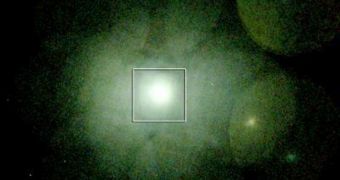At the beginning, our Universe wasn't a very complex place, from a chemical perspective. Hydrogen and helium, the first two elements in the periodic table, reigned supreme, as they still do today, inside stars and massive gas clouds across the Cosmos. Later on, heavier elements developed, like metals and non-metals. Metallic compounds began to form the basis for solid structures, such as planets and moons, which appeared millions of years after the Big Bang. Now, the Suzaku X-ray observatory has managed to identify the largest known intergalactic “treasure trove” of rare elements ever discovered.
The orbiting telescope, which is managed jointly by NASA and the Japanese space agency JAXA, observes the skies in X-ray wavelengths, and is therefore equipped to notice such structures. Following a series of recent observations, its team announced that the instruments aboard the observatory were able to find the largest known reservoir of rare metals ever. The elements chromium and manganese make up the bulk of the structure, which lies in the central regions of the Perseus galaxy cluster. The investigators say that the elements make up most of the “intergalactic medium,” the hot gas that lies between galaxies, ScienceDaily reports.
“This is the first detection of chromium and manganese from a cluster. Previously, these metals were detected only from stars in the Milky Way or from other galaxies. This is the first detection in intergalactic space,” JAXA astrophysicist and Perseus study leader Takayuki Tamura says. The find was made possible by Suzaku's ability to split the X-rays emanating from the interstellar medium into their individual wavelengths, or spectrum. This type of analysis offers a clear view of all the chemical elements that form the object emitting the radiation. Each of these chemicals has its unique signature.
Measurements of the total amounts of rare metals in the region indicate massive numbers. The chromium weighs in at about ten trillion times the mass of our planet, or 30 million times the mass of the Sun, whereas the manganese only exists in concentrations eight million times higher than the mass of the Sun. All these amounts of metal were discovered within Suzaku's own field-of-view, which spans a staggering 1.4 million light-years in diameter, the team reports.
“By measuring metal abundances, we can understand the chemical history of stars in galaxies, such as the numbers and types of stars that formed and exploded in the past,” Tamura concludes. Details of the groundbreaking observations appear in the November 1 issue of The Astrophysical Journal Letters.

 14 DAY TRIAL //
14 DAY TRIAL //